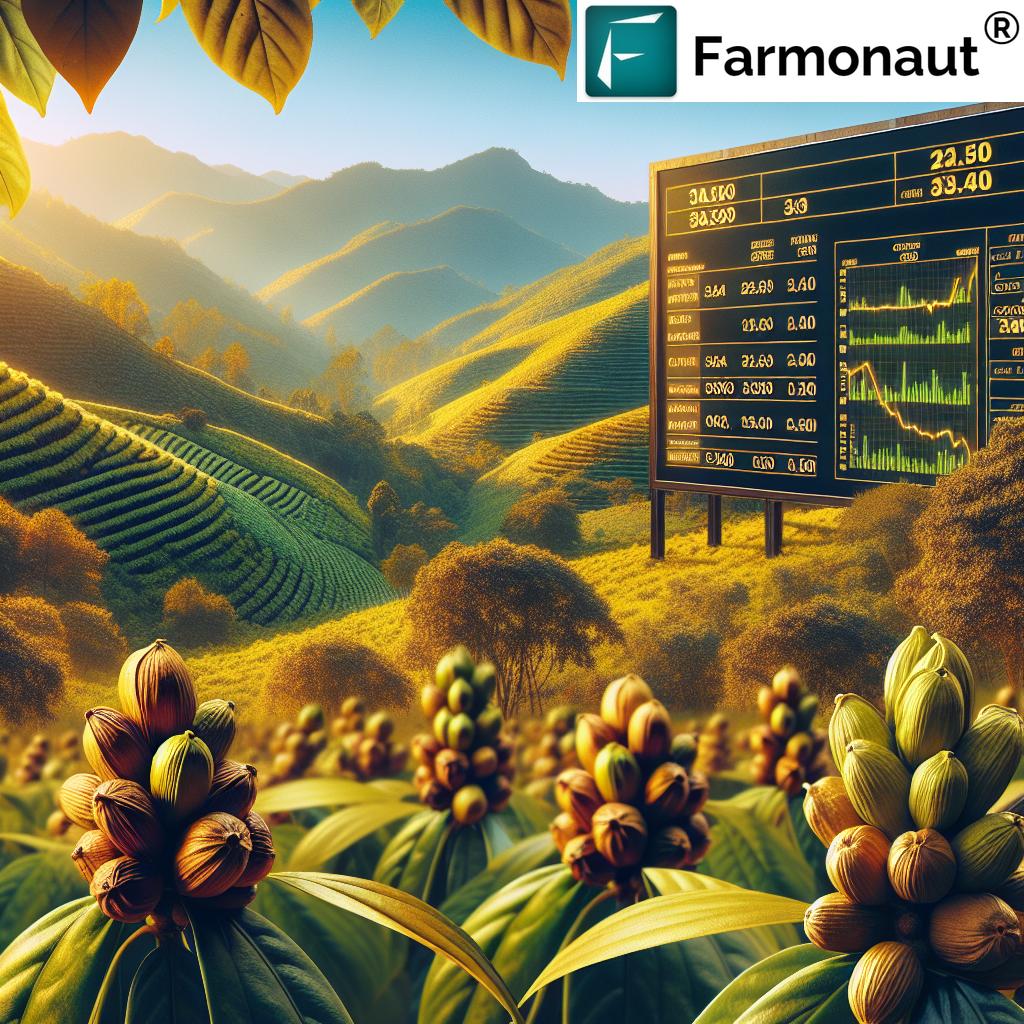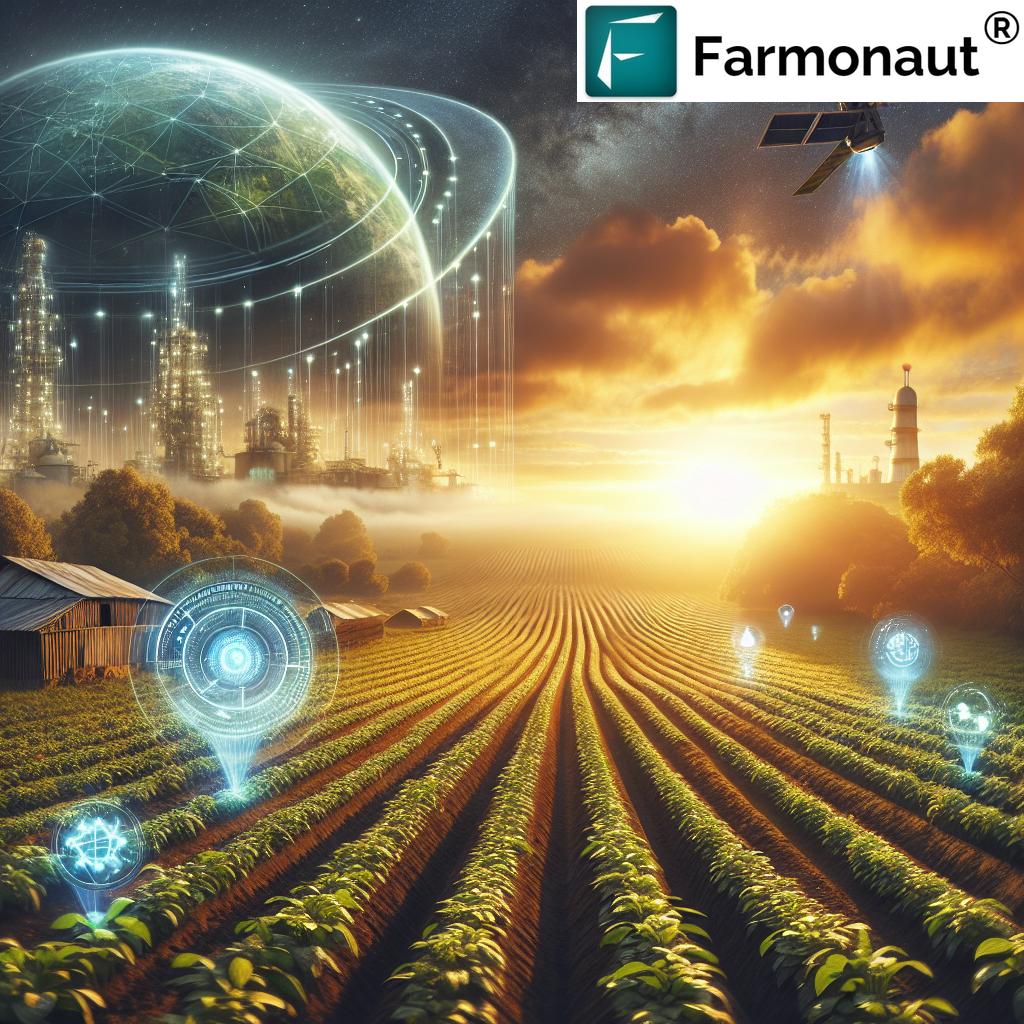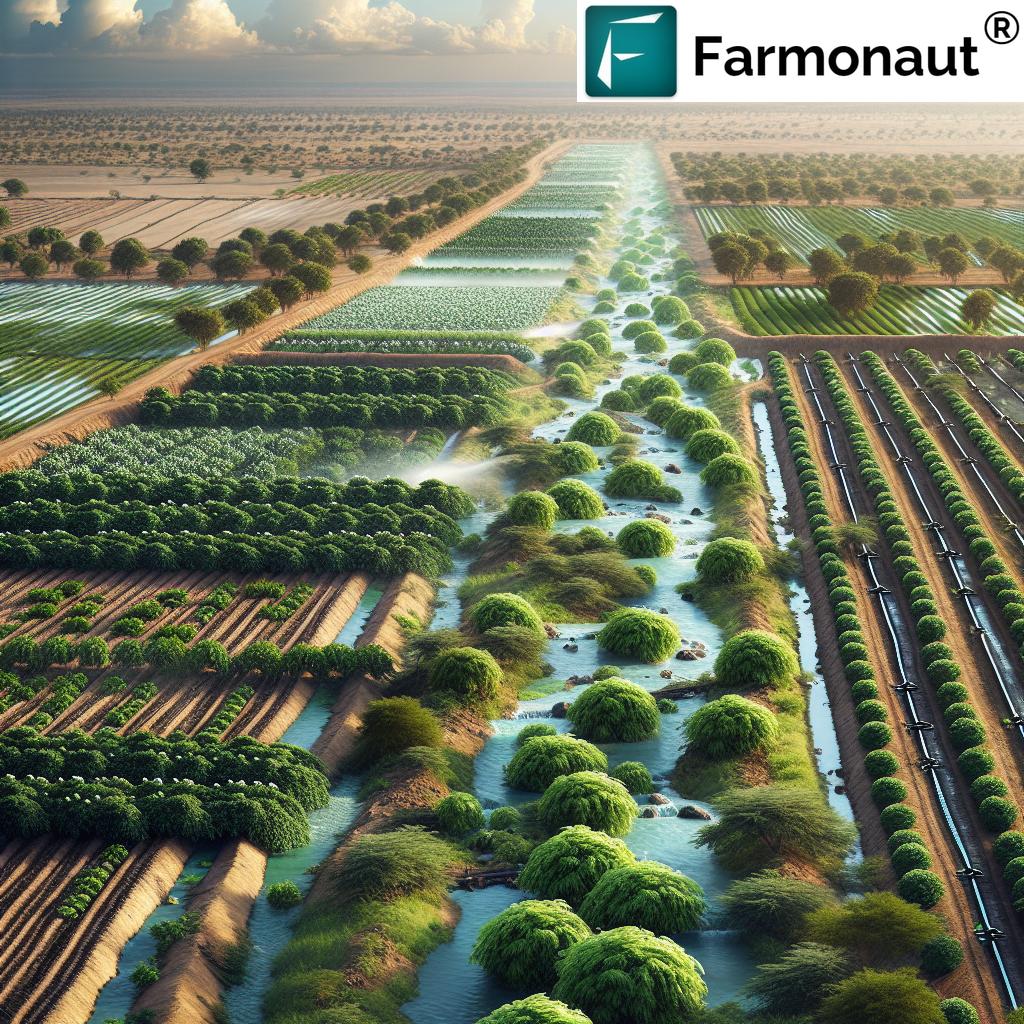Table of Contents
- Introduction
- Understanding Agriculture Drainage Systems in India
- Types of Drainage in Agriculture
- Agriculture Drainage Challenges in India
- The Emergence of IoT in Agriculture Drainage
- Comparison Table: Traditional vs. IoT Solutions
- Farmonaut’s Role in Modernizing Agriculture Drainage
- Future Trends & Innovations (2025 and Beyond)
- Frequently Asked Questions (FAQ)
- Conclusion
“India loses up to 2.5 million hectares of farmland to waterlogging annually, highlighting the urgent need for advanced drainage systems.”
Agriculture Drainage System in India: IoT Types & Innovations
Modernizing Agriculture Drainage Systems in India: The Role of IoT and Sustainable Practices
Efficient water management stands as the cornerstone for sustainable agriculture in India—a country where a significant portion of the population depends on farming for their livelihood. An agriculture drainage system is an essential component in any effective agriculture system in India as it plays a vital role in maintaining soil health, optimizing yields, and preventing waterlogging, salinity, and environmental issues. As Indian agriculture strides into 2025 and beyond, integrating traditional drainage practices with advanced IoT (Internet of Things) technologies promises a transformative impact on productivity, sustainability, and rural resilience.
Understanding the Agriculture Drainage System in India
The term agriculture drainage refers to the removal of excess surface and subsurface water from soil in order to improve crop conditions and yields. This aspect is crucial in an agriculture system in India where rainfall is variable and regions are prone to both flooding and drought, often within the same year.
- Waterlogging leads to crop diseases, damages roots, reduces oxygen availability, and promotes stagnant conditions that diminish yield and compromise plant health.
- Proper drainage enhances aeration, supports nutrient uptake, boosts healthy root development, and ensures timely field operations.
- Maintaining optimal water levels in soil is vital for improving resilience against extreme weather, resulting in better food security for millions in India.
Inadequate or inefficient drainage systems can have adverse effects, increasing soil salinity, reducing fertility, and limiting the productivity of farm lands in Indian states like Punjab, Haryana, West Bengal, and Odisha. Sustainable management requires innovative approaches to drainage.
Types of Drainage in Agriculture: Traditional and Modern Systems
Let’s explore the types of drainage in agriculture used in India and pinpoint how IoT agriculture systems are revolutionizing traditional approaches.
1. Surface Drainage Systems
- Designed to remove excess water from the soil surface via slope design, furrows, or shallow ditches.
- Widely used in regions with heavy rainfall (e.g., Assam, Kerala, parts of West Bengal).
- The method increases natural runoff and prevents rainwater stagnation.
2. Subsurface Drainage Systems
- Involves installation of underground pipes (tile drains) to remove excess water from the root zone.
- Essential for clayey, poorly drained soils in northern states like Punjab and Haryana where the water table often rises.
- Prevents subsurface waterlogging and reduces salinity risks.
3. Open Drainage Systems
- Utilizes open channels or canals to direct water away from fields.
- Cost-effective but requires continual maintenance to prevent erosion, blockage, and contamination from agricultural runoff.
- Popular in eastern India and coastal regions (e.g., Odisha, Andhra Pradesh).
4. Vertical Drainage Systems
- Employs deep wells to lower the groundwater table in areas where subsurface water is high and the danger of salinity looms large.
- Effective but less common, deployed in locations like Gujarat and Rajasthan where groundwater salinity is a problem.
Each of these systems plays a vital role in regional water and soil health management. However, challenges in maintenance, cost, and adaptability have limited their widespread, long-term effectiveness. That’s where technology-driven IoT agriculture system models come in.
Agriculture Drainage Challenges in India: The Reality & The Need for Change
Despite the critical importance of agricultural drainage in promoting sustainable agriculture system in India, many regions struggle due to:
- Limited infrastructure: Most smallholder plots rely on outdated, manual systems that can be inefficient or unable to cope during intense rainfall or irrigation cycles.
- Heavy clay soils: Found in states like Punjab, Haryana, and parts of Maharashtra, these soils hinder natural runoff and increase waterlogging risk.
- Variable rainfall: Erratic monsoonal patterns in India mean some areas face flood-like conditions while others endure drought, demanding adaptive solutions.
- Salinity buildup: Especially in arid and semi-arid zones like Gujarat and Rajasthan, high water tables promote upward movement of salts, degrading soil fertility.
- Poor maintenance and lack of awareness: Traditional drainage channels often get clogged, reducing their efficiency and increasing cost burden over time.
- Climate change: Intensifies these challenges, making traditional solutions unsustainable for the long-term health of Indian agriculture.
With Indian agriculture supporting more than half the nation’s population, the stakes are high. Modernizing agriculture drainage systems with digital, data-driven approaches is not a luxury, but a necessity to sustain yields, livelihoods, and environmental resilience.
The Emergence of IoT Agriculture System in Drainage: Smart Agriculture for a Sustainable 2025
“Over 35% of new agriculture drainage projects in India now implement IoT sensors for real-time water management.”
The Internet of Things (IoT) has emerged as a revolutionizing force for the agriculture system in India. Leveraging interconnected sensors, automated controls, and cloud-based analytics, an IoT agriculture system transforms traditional drainage systems into intelligent networks capable of self-diagnosis and proactive management.
How IoT Improves Drainage & Water Management
- Real-time soil moisture and water table monitoring: Sensors capture moisture levels at multiple soil depths, transmitting data instantly via mobile, app, or web dashboards.
- Automated control of drainage infrastructure: Pumps, gates, and valves can be managed remotely based on sensor feedback, ensuring timely removal of excess water without human intervention.
- Predictive analytics: When integrated with weather forecasts (including satellite data from providers like our team at Farmonaut), IoT systems can anticipate floods or droughts, allowing for actionable early warnings.
- Water use optimization: By applying the right amount of irrigation and drainage only where needed, IoT-driven management reduces wastage and supports sustainable practices.
- Data-driven decisions: Comprehensive datasets on soil health, water movement, and climate trends empower better planning and resource allocation for Indian farmers.
An IoT agriculture system makes precision agriculture possible for a wider set of Indian farmers, regardless of field size or crop. Even smallholders benefit from affordable, remote insight into soil moisture, nutrient levels, and water availability.
To learn how satellite and AI-powered insights further enhance water management and precision irrigation, explore Farmonaut’s Large-Scale Farm Management solutions here. Our technologies enable you to monitor moisture status, plan drainage timings, and remediate waterlogging—all via user-friendly apps and web tools.
Comparison of Agriculture Drainage Systems and IoT Solutions in India
| Drainage System Type | Key Features | Estimated Installation Cost (INR/acre) | Maintenance Requirements | IoT Integration Level | Yield Improvement Potential (%) | Waterlogging Reduction (%) | Suitability for Crop Types |
|---|---|---|---|---|---|---|---|
| Open Drains (Traditional) | Surface water removal via channels/canals; simple construction | 2,000–8,000 | High (prone to blockages, erosion, weed growth) | Low (manual monitoring) | 10-20% | 20-35% | Paddy, Sugarcane, Pulses |
| Subsurface Tile Drainage | Underground pipes for excess water table management, controls salinity | 15,000–40,000 | Medium (periodic flushing, silt removal) | Low–Medium (manual or limited sensors) | 20-40% | 40-60% | Wheat, Cotton, Pulses, Oilseeds |
| Vertical Drainage (Deep Wells) | Deep tube wells lower groundwater table, tackles salinity/waterlogging | 30,000–80,000 | Medium–High (energy/fuel, periodic maintenance) | Low | 25-50% | 40-70% | Cotton, Wheat, Groundnut |
| IoT-Enabled Moisture Sensors | Real-time soil data, automated alerts, predictive analytics | 6,000–20,000 | Low (calibration, sensor checks) | High (smartphones/cloud dashboard) | 25-45% | 50-80% | All major crops, high-value horticulture |
| Automated Drainage Control | Sensors + remotely managed gates/pumps, data-based scheduling | 40,000–120,000 | Low (system inspections, digital maintenance) | Very High (IoT, AI, Satellite integration) | 40-55% | 75-95% | Rice, Wheat, Sugarcane, Bananas, Horticulture |
Key insights: The shift toward IoT-enabled solutions delivers greater yield improvement and waterlogging reduction potential—with less ongoing maintenance. These systems suit a wide range of crop types and farm scales, accelerating the modernization of Indian agriculture.
Farmonaut’s Role in Digitally Modernizing the Indian Agriculture Drainage System
As a leader in satellite technology for agriculture, we at Farmonaut deliver state-of-the-art solutions for regional water management, agriculture drainage system improvements, and sustainable practices. By combining satellite-based monitoring, AI-powered advisories, and real-time analytics, we equip Indian farmers and farm managers to make data-driven decisions for healthier soils, more efficient drainage operations, and better yields.
- Satellite-Based Monitoring: We use multi-spectral satellite imagery to monitor crop growth, detect early signs of waterlogging, assess soil moisture, and flag drainage issues before they impact yield or food security.
- Jeevn AI Advisory System: Our AI-powered system delivers custom advice and weather-based predictions, so Indian farmers deploy drainage measures at the right time—improving response to rainfall and irrigation cycles.
- Blockchain Traceability: For farm produce or resource use, our blockchain solutions foster transparency and security across supply chains, which helps maintain clarity in product traceability and environmental compliance.
- Resource Management Tools: Fleet and water resource tracking reduce operational costs and boost decision-making for large agriculture operations. Explore our fleet management solutions for efficient farm vehicle, machinery, and equipment utilization.
- Environmental Impact Monitoring: Our platform allows carbon footprint tracking for agriculture, supporting compliance and sustainability. Learn more about carbon footprinting in agriculture here.
All of our insights are made actionable through user-friendly mobile and web applications, scalable APIs (API platform), and developer documentation for custom solution integration. These tools help Indian farms of all sizes enhance water use efficiency, reduce the risks of waterlogging and salinity, and manage sustainable drainage operations for years ahead.
Future Trends & Innovations for Agriculture Drainage in India (2025 & Beyond)
The integration of IoT, satellite, and AI-driven systems marks a transformative phase for the agriculture drainage system in India. By 2025, expect the following innovations to become standard across leading Indian regions:
1. Multi-layer Sensor Networks
- Mobile and fixed sensors monitoring soil moisture, water table depth, pH, and nutrient dynamics in real-time.
- Seamlessly integrate data from satellite and drones for whole-field analysis.
2. Automated Drainage Infrastructure
- AI-based scheduling of pumps, sluice gates, and valves based on actual field data, reducing manual input while optimizing water removal.
- Remote control from apps or browser, making drainage management accessible everywhere.
3. Predictive Analytics and Advisory Systems
- Tools like Farmonaut’s Jeevn AI integrate weather forecasts with historical drainage performance and crop data to deliver actionable recommendations for each growing cycle.
4. Blockchain Traceability for Water Resource Management
- Ensures transparency of irrigation, drainage, and water use in supply chains, essential for food safety and export markets.
5. Integrated Crop-Loss Mitigation Systems
- Farmers can utilize satellite-based crop loan and insurance services to access financial protection against waterlogging, drought, or extreme weather losses.
6. Circular Water Management & Artificial Wetlands
- Closed-loop drainage that recycles and purifies runoff, supporting groundwater recharge and biodiversity.
With these technologies and practices, India is positioned to make its agriculture drainage system a model for the world, ensuring reliable water access, improved crop health, and resilience to climate volatility. To explore how digital water management is revolutionizing modern farming, watch the following educational videos:
Frequently Asked Questions (FAQ) on Agriculture Drainage System & IoT in India
What is an agriculture drainage system and why is it important?
It refers to the removal of excess water—both surface and subsurface—from agricultural fields to prevent waterlogging, salinity, soil erosion, and crop diseases. Efficient drainage helps improve soil health, boost yields, and sustain farm productivity.
What are the different types of drainage in agriculture in India?
The four primary types: Surface drainage (furrows, ditches), subsurface drainage (tile or pipe drains), open drainage (channels/canals), and vertical drainage (deep wells).
How does IoT improve the agriculture drainage system?
IoT agriculture systems deploy sensors and real-time monitoring, enabling automatic and data-driven management of drainage. This allows for timely water removal, prevents waterlogging, and supports more sustainable water use across Indian farms.
What are the key benefits of using IoT for water and drainage management?
- Prevents over-irrigation and waterlogging
- Improves crop yield and soil fertility
- Reduces waste and energy consumption
- Promotes sustainable practices, adapts to climate variability
Are IoT-based drainage systems affordable for small farmers?
Yes! Thanks to cost reductions and platforms like Farmonaut, IoT monitoring via smartphone or SMS is increasingly affordable and user-friendly for Indian smallholders.
Does Farmonaut provide direct installation of drainage hardware?
No, we do not install physical farm infrastructure. We provide data, AI advisories, monitoring, and digital insights via satellite, web, and app, empowering farmers to implement effective and timely drainage management practices.
Where can I learn more about Farmonaut technology and pricing?
Visit our web, Android, or iOS apps, or try our API solution for seamless integration. For detailed product documentation, refer to our developer docs.
Conclusion: The Role of IoT & Smart Drainage in India’s 2025 Agricultural Renaissance
Modernizing the agriculture drainage system in India is no longer about simply digging more ditches or laying pipes—it’s about intelligently responding to real-time, field-specific data. The rise of IoT agriculture system solutions, especially when integrated with accessible platforms and satellite monitoring offered by companies like Farmonaut, empowers Indian farmers to:
- Prevent crop losses from waterlogging and salinity
- Maximize yields and field productivity on both large and small farms
- Promote sustainable water management practices suited to India’s climate challenges
- Protect rural livelihoods for a significant portion of India’s population
- Enhance environmental sustainability—preserving healthy soil for generations to come
The adoption of IoT, AI, blockchain, and satellite-driven advisories for agriculture drainage represents a transformative leap. As India moves confidently into 2025, the synergy between technology and tradition will define how well we secure our food future, support our farming communities, and steward our natural resources.
Empower your farm or agri-business for the future. Join us at Farmonaut—where satellite, data, and digital innovation make sustainable, profitable agriculture a reality.
All copyrights reserved © Farmonaut Technologies 2025.













